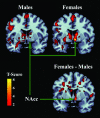Sex differences in brain activation elicited by humor
- PMID: 16275931
- PMCID: PMC1277963
- DOI: 10.1073/pnas.0408456102
Sex differences in brain activation elicited by humor
Abstract
With recent investigation beginning to reveal the cortical and subcortical neuroanatomical correlates of humor appreciation, the present event-related functional MRI (fMRI) study was designed to elucidate sex-specific recruitment of these humor related networks. Twenty healthy subjects (10 females) underwent fMRI scanning while subjectively rating 70 verbal and nonverbal achromatic cartoons as funny or unfunny. Data were analyzed by comparing blood oxygenation-level-dependent signal activation during funny and unfunny stimuli. Males and females share an extensive humor-response strategy as indicated by recruitment of similar brain regions: both activate the temporal-occipital junction and temporal pole, structures implicated in semantic knowledge and juxtaposition, and the inferior frontal gyrus, likely to be involved in language processing. Females, however, activate the left prefrontal cortex more than males, suggesting a greater degree of executive processing and language-based decoding. Females also exhibit greater activation of mesolimbic regions, including the nucleus accumbens, implying greater reward network response and possibly less reward expectation. These results indicate sex-specific differences in neural response to humor with implications for sex-based disparities in the integration of cognition and emotion.
Figures




References
-
- Gray, J. (1992) Men Are From Mars, Women Are From Venus (Thorsons/Harper Collins, New York).
-
- Nowicka, A. & Fersten, E. (2001) Cognit. Neurosci. Neuropsychol. 12 4171-4175. - PubMed
-
- Allen, L. S. & Gorski, R. A. (1991) J. Comp. Neurol. 312 97-104. - PubMed
-
- Henman, L. D. (2001) Humor 14 83-94.
-
- Lefcourt, H. M., Davidson-Katz, K. & Kueneman, K. (1990) Humor 3 305-321.
Publication types
MeSH terms
Grants and funding
LinkOut - more resources
Full Text Sources

